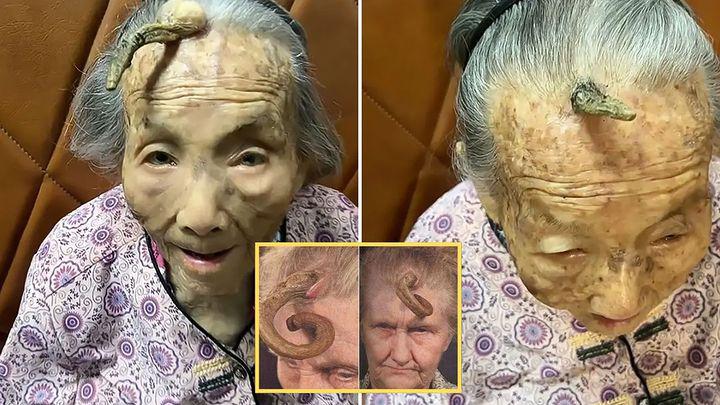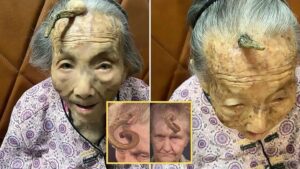NEWS
“This is too risky”: 107YO went viral because the 4-inch “Longevity Horn” growing on her forehead was said to be due to… see more

A 107-year-old Chinese woman has left social media users stunned after revealing a massive horn growing from her forehead.
The lady, Chen, has become a sensation on the Asian platform Douyin after a video showcasing her strange four-inch protrusion went viral. Netizens have dubbed the growth a “longevity horn,” believing it possesses magical properties that explain Chen’s impressive age
Highlights
107-year-old Chen went viral for her 4-inch ‘longevity horn’ on Douyin.
Dermatologists identify the horn as a cutaneous horn, not magical.

Half of such horns may be pre-malignant or malignant, linked to skin cancer.
Doctors advise removing the horn to check for malignancy, despite concerns.
Not only has Chen led an unusually long life, but she remains in excellent health. Those close to her describe her as having a strong appetite and a cheerful disposition, with her viewers believing the horn to be the secret to keeping her healthy.
Do not remove it under any circumstances!” one viewer warned. “My grandmother had a similar growth removed and passed away just days later!”
A 107-year-old woman in China went viral after she showcased a large 4-inch “horn” growing on her forehead
The horn has no magical properties or health benefits despite what Chen’s followers may believe.
Dermatologists describe these strange occurrences as cutaneous horns, rare, cone-shaped skin growths akin to animal horns, coral, or wood that are more common in older patients around 60 to 70.
The “horns” are caused by an overgrowth of the skin’s foremost superficial layer, the epidermis, and are thus white or yellow. They are usually benign, causing no damage to the person other than potentially breaking or causing inflammation
Half of them, however, are described as pre-malignant or fully malignant, which means they are indicative of skin cancer. While both types of horns look similar, dangerous ones are more common in older patients and males than females.
The malignant variant is called Squamous Cell Carcinoma and is more likely if the horn is painful, large, has significant induration at the base, features a broad base, and has a degree of redness
While some of Chen’s viewers pleaded with her family not to remove the massive horn on her forehead, doctors recommend excision as soon as possible to examine the tissue and determine whether the growth is benign or malignant
“Histological examination of the horn base is crucial to rule out malignancy,” explained Dr. Tina Tian of Hawke’s Bay Hospital in New Zealand. “There are no certain clinical features that can definitively distinguish benign lesions from skin cancer.”

Cutaneous horns can effectively grow anywhere on the body, including private areas, but are more common on sun-exposed areas like the head, ears, back of the hands, forearms, neck, or shoulders.
According to Dr. Tian, it’s impossible to assess whether Chen’s horn is indicative of a type of cancer, but before-and-after photos show that the horn has doubled in size in recent years, developing a large base and becoming darker in color.











